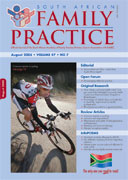CPD: Effectiveness and safety of new-generation antihistamines in allergenic rhinitis and urticaria.
Abstract
Allergic diseases are on the increase, affecting 30-40% of the population. Histamine remains the most important mediator of clinical reactions in allergic diseases such as rhinitis, urticaria, and food and drug allergies. The need for more effective and safe antihistamines is critical and intensive drug development has become more demanding and competitive. Although the old “first generation antihistamines were effective, major limitations included their strong potential for sedation and their anti-cholinergic side effects. Not only could patients not function well in their normal daily activities, but these medications posed an important risk for safety, particularly for motor vehicle drivers and machine and precision instrument operators. Unacceptable side effects were a particular problem in the elderly. In May 2001, CONGA, an international consensus group, convened to formulate guidelines for the development of new antihistamines. Several important areas were reviewed and a document of recommendations was published, focusing specifically on the safety and efficacy aspects of antihistamines.1 (SA Fam Pract 2004;47(1): 24-28)
Published
2005-08-01
Section
Review Articles
By submitting manuscripts to SAFP, authors of original articles are assigning copyright to the South African Academy of Family Physicians. Copyright of review articles are assigned to the Publisher, Medpharm Publications (Pty) Ltd, unless otherwise specified. Authors may use their own work after publication without written permission, provided they acknowledge the original source. Individuals and academic institutions may freely copy and distribute articles published in SAFP for educational and research purposes without obtaining permission.

